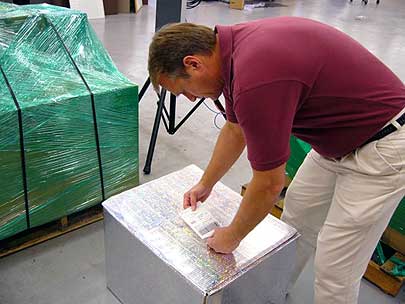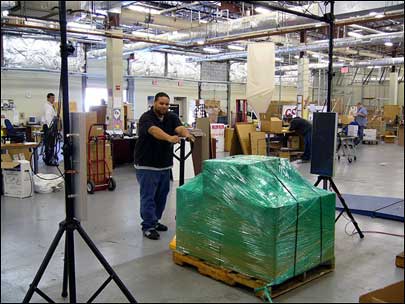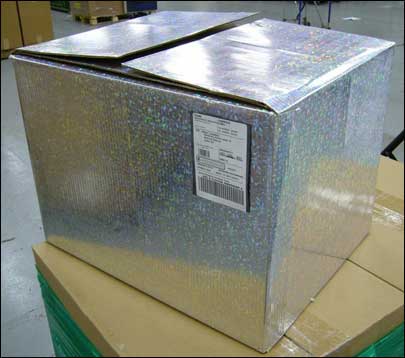Oct 24, 2005Government Scientific Source (GSS) sells or distributes hundreds of thousands of different items used by medical clinics and laboratories, from Petri dishes and other disposable items to bulk quantities of chemicals, electron microscopes, gas chromatographs and other high-tech instruments. The company purports to be the largest dedicated distributor of scientific equipment and supplies to federal, state and municipal government laboratories.
GSS processes approximately 40,000 orders each year, and most recipients for those orders are federal agencies, many within the Department of Defense (DOD). Because of that, the letters RFID became important to GSS vice president of sales Steve Sellentin more than two years ago, when the DOD first announced its plans to begin requiring suppliers to begin tagging cases and pallets of goods with RFID tags.

While GSS ships goods to the DOD largely on the behalf of manufacturers who have DOD contracts, the company also has two direct supplier contracts with the DOD. The Defense Logistics Agency, which procures goods for the DOD, has already told GSS that if the company wants to keep these contracts, it will most likely need to start tagging cases and pallets of many it distributes to the DOD, starting as soon as January 2006.
GSS has more than its own DOD contracts in mind, however. As a distributor, GSS wants to offer RFID tagging as a value-added service to its customers also coming under the DOD mandate. "A supplier called me the other day and asked, 'Do you know about this RFID stuff?' I told him, 'We're already on it,'" says Sellentin.
According to Sellentin, RFID tagging will be an extension of the services it already offers customers. "Our role is to help manufacturers, corporations and other distribution companies move product into the federal government. Now that RFID has become a reality for us, we have the ability to help [our customers] get items tagged properly. Otherwise, [they] will get this service from somebody else," he says.
Sellentin expects that as many as 25 of the vendors using GSS distribution services to ship goods to the DOD will take the company up on its offer to provide tagging services, as well. The tagging service will consist of printing RFID smart labels and encoding the embedded RFID inlay in the label with an EPC that meets DOD requirements. After verifying that the tag is accurately coded and functioning, GSS will apply the tags on the cases and pallets. Once the pallets for each order have been loaded, GSS will verify that all goods in the order have been accurately picked before sending the shipment. It will also aggregate the EPCs assigned to the tags in each order, then send them to the receiving agency in an advance ship notice.
All hardware, software, installation and integration services and training GSS has received has been complimentary, Sellentin says, as these vendors believe their relationship with GSS will lead to contacts with other DOD suppliers. The only cost the company has incurred to deploy its RFID system has been the amount of time he and his staff have spent learning how to use it. Consequently, the tagging service is likely to generate profits quickly for GSS.
GSS knows, however, that RFID tagging will be required by a number of federal departments and agencies, including the General Services Administration (GSA), which does most of the government's non-defense buying. "We know now that some of the civilian agencies, such as the GSA, want to start using RFID as well, and we have a number of GSA contracts for clinical lab and clinical research laboratory equipment and supplies," says Sellentin.

"The GSA is getting pressure from DOD customers within the federal government and the civilian agencies, like the Department of Health and Human Services, to modernize and computerize ordering, receiving product, the paying of invoices. But not being able to efficiently receive the products that are coming into the federal government's delivery sites has always been the weak link in the entire process," he says, putting much of the blame on labor-intensive, paper-based systems often used to receive goods.
"[RFID] is a great way to bring the delivery services in these major facilities into the 21st century," he says. That’s because these agencies will be able to receive goods in inventory automatically by reading the RFID tags.
Shortening the receiving process at government facilities will also benefit companies like GSS, which distributes many temperature-sensitive products used in the life sciences. These goods are often packed in ice, and if not processed in a timely manner, they could spoil. When items spoil, GSS is sometimes held responsible, depending on whether they become unusable before or after being received into the agency's inventory. Though he won’t reveal the exact amount, Sellentin says GSS loses revenue each year because temperature-sensitive goods are not received into agencies' inventories promptly.
Setting Up Shop
To help devise an RFID system that would enable it to meet the DOD mandate, GSS worked with Dallas-based systems integrator Enterprise Information Systems (EIS) earlier this year. During a week in July, EIS installed a simple RFID tagging station within GSS' distribution center and provided basic RFID education to select GSS staff, says Brian Aldridge, an RFID systems analyst for EIS.
"We started the week with what we call our 'My RFID' seminar, during which we educated employees throughout GSS, such as those on the shipping dock, people in IT, finance and customer support, on the basics of RFID and how it works." But EIS also derived some value from these sessions by learning about the business processes in place at GSS. "We told them what they'll need to do in order to comply with the mandate. And then they went through their business process with us," he says. "This educated us on any unique needs they had."
For hardware, GSS is using a prepackaged solution from RFID reseller ScanSource. The kit includes Symbol Technologies' MC9000-G RFID handheld RFID and bar code reader, a portal interrogator from Symbol, Zebra Technologies' R110 Xi printer-encoder and a roll of UHF EPC Class 0+ passive Symbol tags. How many orders GSS could process with this small hardware infrastructure is hard to determine, partly because it depends on the process flows required, and how consistently the applied RFID tags can be read and verified.

Once the system was installed, Aldridge says, GSS staff processed 10 pallets per day for training purposes. He believes the system could process many more pallets per day, but that adding more printer-encoders and interrogators would provide redundancy and an extra tagging station for periods of high tagging volumes.
The sample cases contained products ranging from RF-friendly goods, such as microscope slides, to those likely to cause interference—chemicals and other liquids, for example, that absorb RF signals, or metal tools and instruments that reflect RF signals. Also, roughly 10 percent of GSS shipments must be temperature controlled because they contain chemicals or other agents, many of them used in life sciences applications, that become unusable if they spoil. These are generally sent overnight through shipping provider DHL, and are placed in specialized cardboard boxes covered in foil and lined with an insulating foam. Because these goods are kept at temperatures as low as -40 degrees Celsius, EIS stored a number of the Symbol tags at such temperatures overnight to see if the circuitry within a tag's chip, and the connectivity points between the chip and antenna, would remain sound and functioning. These test results were positive, says Aldridge.
EIS helped GSS devise a way to tag these boxes so the foil covering them would not interfere with the RF signal. This was accomplished by placing a smart label atop a rubber plate fastened to the box. EIS then worked with GSS staff to determine how they could retrofit some of their packaging processes and materials to ensure the readability of tags attached to cases of the most troublesome products.
They discovered that some products need to be covered by an extra layer of cardboard, and/or a layer of foam underneath the RFID smart label. This serves to isolate the RFID inlay embedded in the label from the material inside the case so that the latter will not cause RF interference.
To provide the software infrastructure GSS needs to generate and manage EPCs, associate them with cases and pallets of goods, manage the RFID devices and generate advance shipment notices (ASNs) for the DOD, EIS selected epcSolutions, a Great Falls, Va., RFID middleware provider.
To make the DOD template, epcSolutions used the department's RFID guidelines, including the data constructs utilized to generate EPCs assigned to goods, translating those rules into a wizard-based software solution. Using the DOD template, the end user establishes a database showing which SKUs it ships to which DOD distribution centers. The template then compares this data to the details of the mandate in order to flag orders that must be shipped with RFID tags.
For now, GSS' RFID system is not integrated with its inventory and warehouse management system. In the coming months, the company says, it will complete an internal upgrade to the latest version of the Microsoft Navision inventory and warehouse management platform it uses to receive, process and prepare orders in its Reston, Va., distribution center. GSS will then closely integrate the RFID system with Navision.Each time Navision receives an order, the epcSolutions software will analyze that order and the ship-to address, cross-referencing this information with the latest list of goods that require tagging. The software will then instruct GSS personnel to generate and apply tags to cases and pallets requiring them.
The epcSolutions platform will associate the EPCs with the order information within Navision. It will also include the EPCs assigned to the tags in the ASNs that must be sent to the DOD through its Web-based Wide Area Workflow system, which it uses to accept goods into its inventory system and generate receipts. Currently, GSS must send these ASNs with EPC data to the Wide Area Workflow manually, using a Web interface.
The Outlook
Though it has established and tested its tagging and verification system and the epcSolutions software, GSS doesn't expect to ship its first RFID-tagged goods to the DOD until January. And while Sellentin has walked a number of its customers through the RFID tagging station, which currently serves as an RFID demonstration area, none have committed to the tagging service. He expects this to change once these suppliers receive their tagging mandates from the DOD and can determine whether they will deploy their own RFID tagging system or opt for outsourcing the service to GSS. Some providers might outsource tagging to GSS only until they can deploy adequate tagging systems within their own facilities.
Although GSS does not yet have any customers committed to the tagging service, Sellentin believes that by getting an early jump on establishing an RFID infrastructure and training the GSS staff to use RFID, it will help the company comply with the DOD mandate and win business from its customers who want to outsource their tagging operations. He also hopes the early work GSS has done to ready itself for the mandate will enable it to retain its current DOD contracts and enjoy a competitive advantage in attaining new government contracts—especially if the GSA rolls out its own mandate. "We're locked and loaded," he says.
